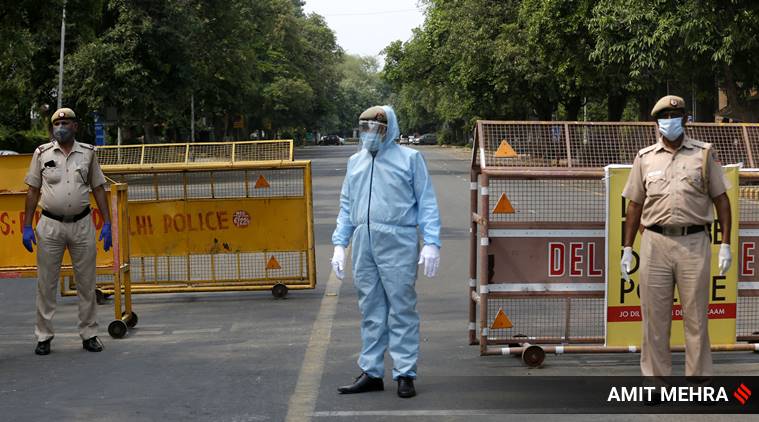 A Delhi police barricading at Bangali Market area, identified as a COVID-19 containment zone during the nationwide lockdown to curb the spread of coronavirus in New Delhi, Tuesday, April 28, 2020. Express Photo By Amit Mehra
A Delhi police barricading at Bangali Market area, identified as a COVID-19 containment zone during the nationwide lockdown to curb the spread of coronavirus in New Delhi, Tuesday, April 28, 2020. Express Photo By Amit Mehra
Over the past two weeks, the number of active Covid-19 cases in Delhi has more than doubled from 3,738 to 8,470. During the same period, containment zones has dropped from 97 to 79. Behind this lies a shift in the Delhi government’s stance concerning containment zones, with the focus shifting from putting entire neighbourhoods under lockdown to zeroing in on residential units housing infected persons.
This also finds reflection in official statements from the government over the past few days, with the thrust on opening up the city while keeping only containment zones under lockdown. At the May 11 meeting with PM Narendra Modi, Chief Minister Arvind Kejriwal had argued that Delhi be allowed to resumed economic activities except in containment zones.
An official privy to discussions between Kejriwal and L-G Anil Baijal said new cases are coming from only around 40 containment zones currently: “If the previous policy was being followed, many non-contained areas would have been sealed by now.”
When contacted, Additional Chief Secretary (Home) Satya Gopal said he was not authorised to share any information. The Delhi government also did not offer any official comment.
Shalimar Bagh, a sprawling neighbourhood in Northwest Delhi, and Shalimar Village, have collectively registered over 100 cases in the past few weeks across all its blocks, official sources said. However, since last month, when a block was sealed, only one more colony — BB Block — in Shalimar Bagh has been locked down. District officials, who did not want to be identified, said AF Block locked down last month is also likely to be de-sealed within the next few days as no fresh case has cropped up in 28 days.
As of May 13, five areas were declared containment zones in Northwest Delhi, which has over 600 active cases.
Senior officials attributed the rise in cases in Shalimar Bagh to the outbreak at Azadpur Mandi. “Nearly no case has any foreign travel history or contact with persons who returned from abroad. So contact tracing has become difficult. The assumption is that most of cases have links with Azadpur Mandi as people from this area frequent the market. Also, vendors from the mandi sell their products here,” said an official.
Tilak Raj Kataria, leader of the house in the North Corporation, who is a resident of Shalimar Bagh, has written to the CM and Northwest District Magistrate Sandeep Mishra, expressing concern over the situation. He suggested the entire area be sealed as a preventive measure.
However, a district official said, the government is very clear on not putting large residential areas under lockdown anymore, like it did initially, only to break down large sealed zones such as Chandni Mahal and Nabi Karim into multiple clusters later.
“The MHA guidelines say that in urban areas, containment zones can be residential colonies, mohallas, municipal wards, police station areas etc, when a cluster of three or more cases come up. Accordingly, we were sealing small lanes, apartments. However, in Delhi, even a municipal ward houses a population of over a lakh. It becomes difficult to monitor such large sealed areas. So, the focus is on mounting surveillance in areas where cases are emerging and sealing particular buildings. In Shalimar Bagh, in most areas, cases ranging from 5-10 have been registered from individual families. So a decision has been taken not to seal entire blocks,” said a district official.
A senior bureaucrat, however, warned that this shift should not be cloaked in opacity, which might leave thousands of people “exposed”: “Even if new containment zones are not notified, people should be made aware where these new cases are coming from. Withholding crucial information such as district-wise figures of active cases and deaths cannot be justified in any manner. The government has also not shared a break-up of cases in containment and non-containment zones.”